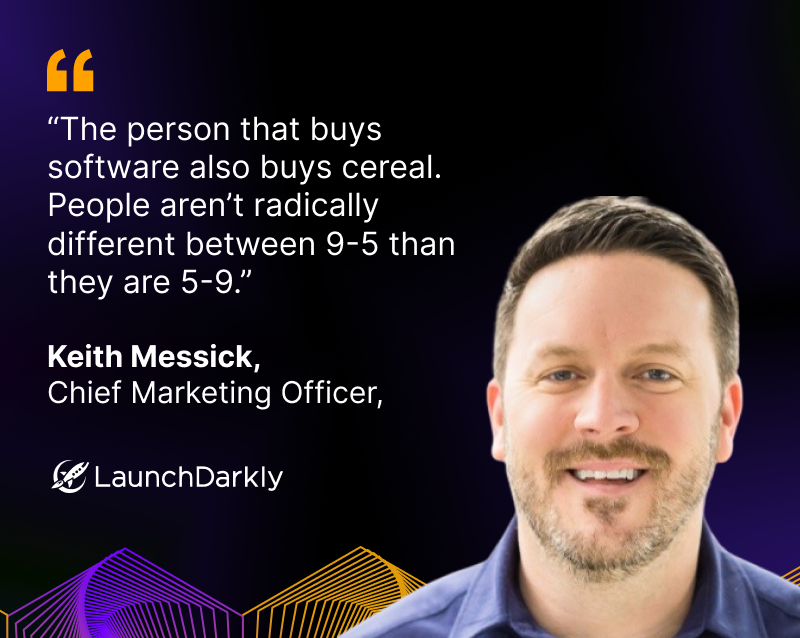The Art and Science of Marketing: Meet Keith Messick from LaunchDarkly

Maximize Your Marketing ROI
Join 10,000 other marketers already getting the best tips on running engaging events that boost pipeline and create raving fans.
In this episode of CMO Diaries, Kishore chatted with Keith Messick, Chief Marketing Officer at LaunchDarkly.
LaunchDarkly provides fast, scalable feature flag and toggle management (feature management) for the modern enterprise. Their solution helps companies innovate faster, reduce risk, and bridge the divide between developers and business.
Keith joined Kishore to talk about some of his most fun marketing campaigns, how to build alignment and trust between marketing and revenue teams, and the challenges of pricing in SaaS (spoiler alert: it’s an art and a science💡).

What are some examples of fun and creative marketing that you’ve tried in the past that’s worked?
While it’s getting better, there used to be this thought in B2B marketing that it was B2B or B2C only. The thought was that the B2B audience is hyper logical, so hit them with ROI calculators. And then the B2C audience is really emotional, and they make snap decisions.
The problem with that line is that it’s the same person. The person that buys software also buys cereal. People aren’t radically different between 9-5 than they are 5-9.
People now tend to agree with this line of thinking, and we now know that B2B buyers buy things for all sorts of emotional reasons. They might justify it with logic at the end so they don’t look like they’re making an emotional decision, but the emotion is still there.

Fun and humor are a great way to hook an audience. The product has to deliver, and the logic behind the decision has to be there at the end, but creativity and humor are a great way to get attention on your brand.
My previous company, DialPad, was built in a somewhat dry space. We unexpectedly launched funny hold music that people could use before conferences. You could even RickRoll someone before your call.
Creativity and humor were core to the ethos of the business, and it worked really well.
Another fun one was an out-of-home campaign with awkward childhood photos of employees, which ended up being great for recruiting as well. We asked folks for their worst childhood photo and used it as the creative for our billboards with the copy, “Middle school is hard, your phone system doesn’t have to be.” At first, folks were very reluctant to participate. But by week three, employees were fighting to get pictures included. It became a fun internal thing. And we were drowning in calls and emails, people just had to see what we were about.
Usually at a startup, you have budget constraints. But in many cases, those constraints yielded a better creative product. You have to figure out, how do we get the most bang for the buck?
If you’re working on a smaller budget, creative is how you make that count.
What’s the most difficult part of asking for the CMO title when you’re a VP of Marketing?
The most difficult part is just asking!
After that, you have to make a case. And, you have to understand the differences in the roles.
First, if you don’t have it, ask your company for role definition between the two titles. That’s the #1 takeaway. You should understand your role, the role above you, and the role beside you so you can see how you’re tracking and what your gaps are.
See what the difference between a VP or Marketing and CMO is according to the company. Then, figure out if you’re already doing that job. A lot of times, the VP of Marketing is already doing the job without the title.
“A lot of times, the VP of Marketing is already doing the CMO job without the title.”
In my experience, the biggest difference between the two is that CMO spends more time on strategy and a lot of boring time with finance. It’s a lot of ratios and models
As far as marketing is concerned, however, the roles aren’t that different.
As marketing continues to be more accountable for revenue and pipeline generation, what would you change to strengthen the partnership between finance or revenue?
This is an interesting question. At LaunchDarkly, we don’t really have this problem. Our team is pretty good at sharing data
One of the first things we did when I came on board was blow up the reporting and re-built all of our reports. We wanted everything to be very transparent. We don’t hide bad news or cherry-pick good data. When you start like that, you build a lot of trust with sales and finance.
This approach also allows us to prove that we’re good stewards of the company’s dollars. We’re not just spending money for the hell of it, there’s an intention behind it, and we have the reports to back it up.
“We have a ‘less feelings, more data’ motto on my team.”
From my experience, when there’s tension between marketing and sales or marketing and finance, it’s marketing’s fault. Marketing isn’t showing up with a lot of data; they’re showing up with a lot of feelings. We have a “less feelings, more data” motto on my team.”
Once people see what’s happening, it really helps to get rid of any tension.
Let’s talk about pricing and packaging. How do you know which features go into each pricing bucket?
Pricing is part art, part science. There’s no way around it.
Your first goal is a mutual exchange of value. You want to get paid and the person paying you wants this thing that they think it’s going to do and hopefully a few things they weren’t expecting. You want that to be as fair as possible. They don’t want to overpay. and you don’t want to undercharge.
Second, you’re trying to understand your audience. There are often features that naturally categorize themselves based on this. For example, large or enterprise companies are going to need more features around governance. Smaller companies don’t have a lot of structure or policies in place yet. So, you’d move those enterprise features into your more robust plans.
It’s not perfect, but there’s some proxy and it can work.
On the low end, you have to work with the product team to understand who is using what and identify the meaningful cliffs on where to segment features. What are the features that your lowest tier wouldn’t be upset if they lost but would meet the needs of a more complex customer?
Ultimately, there’s pluses and minuses to all pricing plans. For example, with a seat-based plan, it’s difficult to grow users of the product because there’s an inherent blocker. You can replace that with consumption-based pricing, but it makes forecasting extremely difficult.
“Pricing is part art, part science. There’s no way around it.”
Do you have any book recommendations?
I am a big Jeffery Moore fan. I loved Crossing the Chasm and his other books. They’re really helpful when you think about the CMO question from earlier. Understanding and having a strong point of view on the strategy from a business perspective is where you’ll make the biggest knowledge and career jumps.

Transform Your Video Marketing with AI
Stay In Touch
Platform
Resources
© 2025 Copyright Goldcast, Inc. All rights reserved.





 Upcoming Events
Upcoming Events Event Series
Event Series On-Demand Events
On-Demand Events

